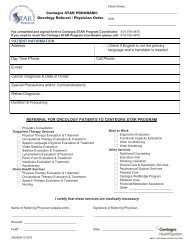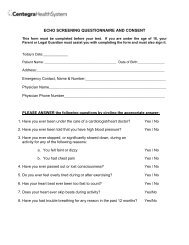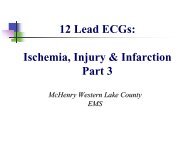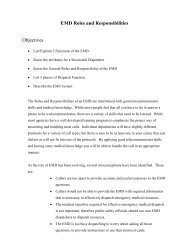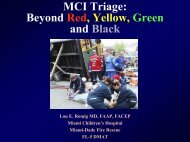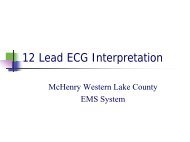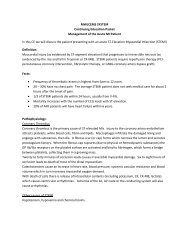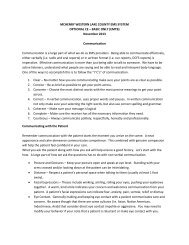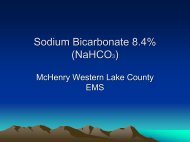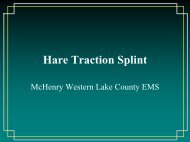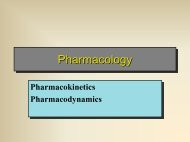Tier II Critical Care ALS Transport
Tier II Critical Care ALS Transport SOP - Centegra Health System
Tier II Critical Care ALS Transport SOP - Centegra Health System
- No tags were found...
You also want an ePaper? Increase the reach of your titles
YUMPU automatically turns print PDFs into web optimized ePapers that Google loves.
<strong>Tier</strong> <strong>II</strong> <strong>Critical</strong> <strong>Care</strong> <strong>ALS</strong> <strong>Transport</strong>1. <strong>Tier</strong> <strong>II</strong> <strong>Critical</strong> <strong>Care</strong> <strong>ALS</strong> <strong>Transport</strong> Paramedic will confirm that patient meets criteria for transportaccording to the MWLCEMS System Patient Triage Criteria and Staffing Requirements Policy and thetransfer order is in place. A copy of the patient medical record and transfer forms will be obtained.2. <strong>Tier</strong> <strong>II</strong> <strong>Critical</strong> <strong>Care</strong> <strong>ALS</strong> <strong>Transport</strong> paramedic will perform a face to face bedside report and assessment with thetransferring nurse according to the MWLCEMS System <strong>Tier</strong> <strong>II</strong> <strong>Critical</strong> <strong>Care</strong> <strong>ALS</strong> <strong>Transport</strong> Assessment and Reportpolicy3. Transfer procedure will be explained to patient and family4. Patient will be prepared for transport.5. <strong>Tier</strong> <strong>II</strong> <strong>Critical</strong> <strong>Care</strong> <strong>ALS</strong> <strong>Transport</strong> paramedic will call report to the Medical Control Physician prior to leaving thetransferring unit.6. MWLCEMS System Standard Operating Procedures/Standing Medical Orders will be in effect during thetransport. Any transfer orders that deviate from the MWLCEMS System Standard Operating Procedures must bediscussed with and approved by the Medical Control Physician prior to transfer.7. Vital signs and mental status will be assess and recorded every 5 minutes during transport.8. Any changes in the patient’s condition during transport must be reported to Medical Control. This includes but isnot limited to:• Deviation from patients normal vital signs• Signs of respiratory distress• Mental status changes• Cardiac dysrhythmiasIf at anytime during transport the patient becomes unstable the <strong>Tier</strong> <strong>II</strong> <strong>Critical</strong> <strong>Care</strong> <strong>ALS</strong> <strong>Transport</strong> paramedic willdivert to the closest hospital and OLMC will be notifiedIV Medication Infusions:1. Patency of IV site will be confirmed by the <strong>Tier</strong> <strong>II</strong> <strong>Critical</strong> <strong>Care</strong> <strong>ALS</strong> <strong>Transport</strong> medic and transferring nurse2. All fluids and medications will be delivered via an infusion pump during transfer.3. IV fluid rates will be confirmed by the <strong>Tier</strong> <strong>II</strong> <strong>Critical</strong> <strong>Care</strong> <strong>ALS</strong> <strong>Transport</strong> paramedic and transferring nurse4. IV medication infusion rates and doses will be confirmed by the <strong>Tier</strong> <strong>II</strong> <strong>Critical</strong> <strong>Care</strong> <strong>ALS</strong> <strong>Transport</strong> paramedic andtransferring nurse5. Ensure all lines and ports are labeled with the names of the infusing fluids or medications.6. <strong>Tier</strong> <strong>II</strong> <strong>Critical</strong> <strong>Care</strong> <strong>ALS</strong> <strong>Transport</strong> paramedic confirms that dose falls within MWLCEMS System approved doserange.7. IV medication infusion rates and doses will NOT be changed during transport unless ordered by OLMC.Mechanical Ventilation:1. Patient’s pre-transfer ventilator setting should be continued. The <strong>Tier</strong> <strong>II</strong> <strong>Critical</strong> <strong>Care</strong> <strong>ALS</strong> <strong>Transport</strong> paramedicshould utilize the respiratory therapist and nurse to adapt to their ventilator if you cannot exactly mimic the settings.2. Respiratory status will be continuously monitored during transport.3. If acute respiratory deterioration occurs and an obvious cause is not immediately determined (i.e. tubedisconnected, tube kinked, etc.) patient will be disconnected from the ventilator and ventilation will beinitiated using a self-inflating resuscitation bag connected to 100% oxygen. A respiratory assessment willbe completed as they divert to the closest hospital and OLMC is notified.Central Lines:1. In an emergent situation (i.e. hemodynamic instability, respiratory failure, cardiac arrest) the <strong>Tier</strong> <strong>II</strong> <strong>Critical</strong> <strong>Care</strong> <strong>ALS</strong><strong>Transport</strong> paramedic may access a preexisting central line following the procedure in the MWLCEMS System AccessingCentral Line policy .
Chest Tubes1. General <strong>Care</strong> according to the MWLCEMS System Chest Tube policy2. Tube dislodged from patient: Ask patient to cough or exhale; apply occlusive dressing, tape on three sides: NotifyOLMC and divert to the closest hospital; Monitor for signs and symptoms of tension pneumothorax, if develops liftside of dressing to allow air release than recover wound.3. Tube disconnected from drainage system: Immediately reconnect; assess patient for signs of respiratory distress;Notify medical control immediately with assessment and for further orders.Gastric Tubes:1. Patients will not be transported with tube feedings infusing.



